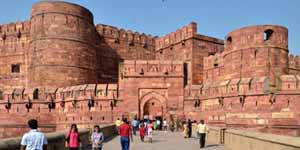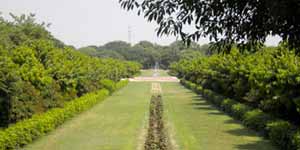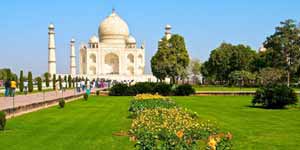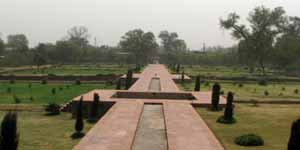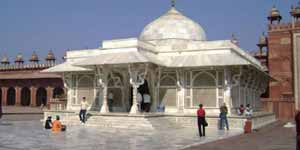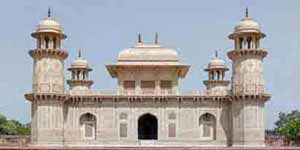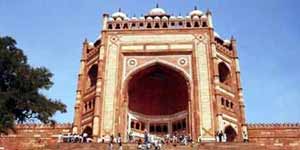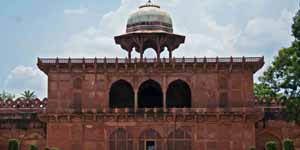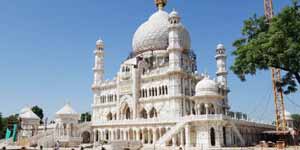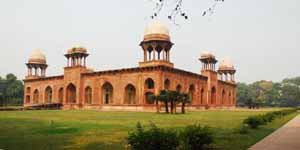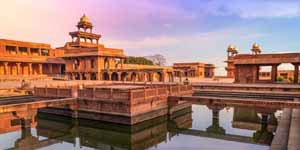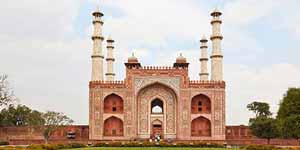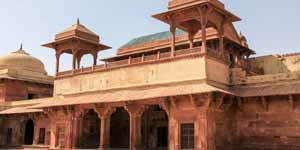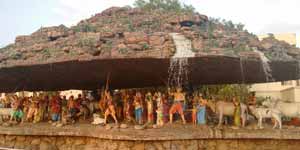

The Tomb of Mariam-uz-Zamani is the mausoleum of Jodha Bai, the Hindu consort of the Mughal Emperor Akbar, located on the left side of Agra-Mathura road, to the west of Akbar's tomb in Sikandra.
The tomb was built by Jahangir in memory of his mother Mariam-uz-Zamani and was located near Akbar's Tomb as per the last wish expressed by her. The structure was originally a baradari under Sikander Lodi who built it in AD 1495. It was later modified into Mughals tomb by reconstructing the 4 facades of the building in Mughal style.
The ground floor consists of around forty chambers built by Sikander Lodi, which bear faint traces of paintings on plastered walls. The centre of the ground floor houses the original cenotaph of Jodha. One can visit the crypt using red sandstone stairs. It was constructed with three tomb stones, the original one is in the ground floor, the middle and terrace stones are design to resemble the same.
This square tomb stands in the centre of the Mughal garden. It is built on a raised platform with stairs on its northern and southern sides. The two corridors running from east to west and from north to south divide the structure into nine sections that are further subdivided into smaller compartments. The tomb is built of brick and mortar, and finished with stucco.
The facades of the baradari had been veneered with red sandstone, which is cut into numerous panels and adorned with geometrical patterns carved in bas-relief. Each corner of the structure is added with an ornamental octagonal tower. This is also made up of red stone along with brackets and pillars. The domes of the towers are white and the lower part of the towers is red.
History
Jodha Bai was the wife of the great Mughal emperor, Akbar. She was the daughter of Hindu Rajputana King Raja Bharmal Kaccwaha of Amber. Rani Jodha Bai was also known by the name Mariam-uz-Zamani. In the year 1569, she gave birth to Salim, who later known as Jahangir. Later in the year 1623, Jodha Bai died in Agra and this tomb was built by Jahangir between 1623 and 1627 A.D.
Architecture
The Tomb of Mariam Zamani boasts an impressive fusion of both Hindu and Islamic architectural design. Built of red sandstone, the famous tourist place in Agra is located in the middle of a garden. It includes two corridors. Besides, the entire structure of the tomb is well-supported by the massive pillars. In total, the tomb is a three storey building; the first one is the grave, cenotaph in the middle floor and third floor is the terrace with a garden. Such is the architectural charm of this must-visit place in Agra that the ground floor houses as more as forty chambers.
Best time to visit
The best time to visit the tomb of Mariam-uz-Zamani is during the months of October to March. The weather is pleasant during this time as it is winter season, perfect for excursion and site seeing. Summer begins in March and lasts till June. While the weather is clear in summers, the heat is unbearable, and therefore it is advised to visit during the winter season.
The entry fee for citizens of India and the SAARC countries is Rs. 10. For foreign nationals, it is Rs. 100. However, children under 15 are exempted from paying entry fee. The site is open from sunrise to sunset on all days.
